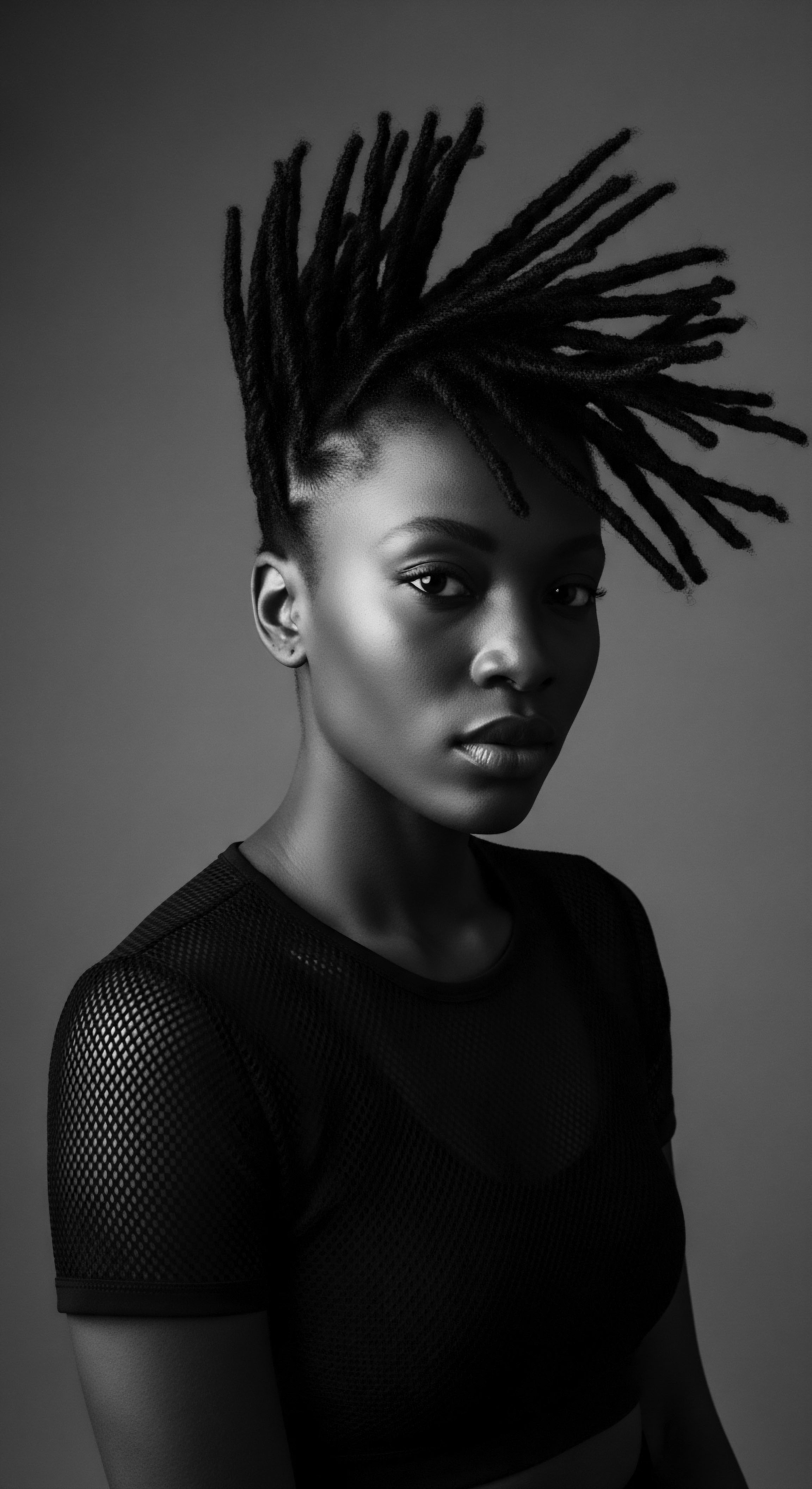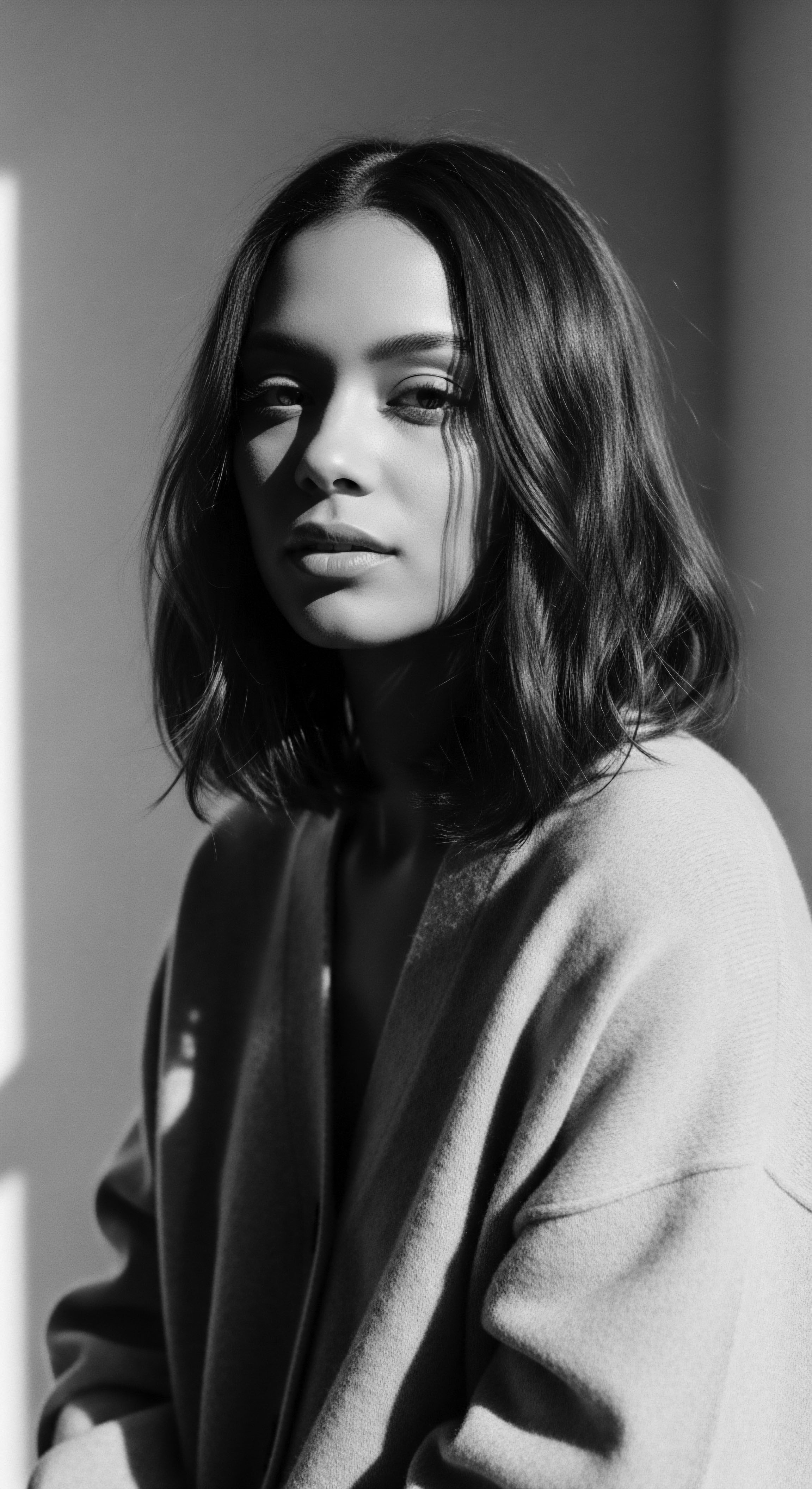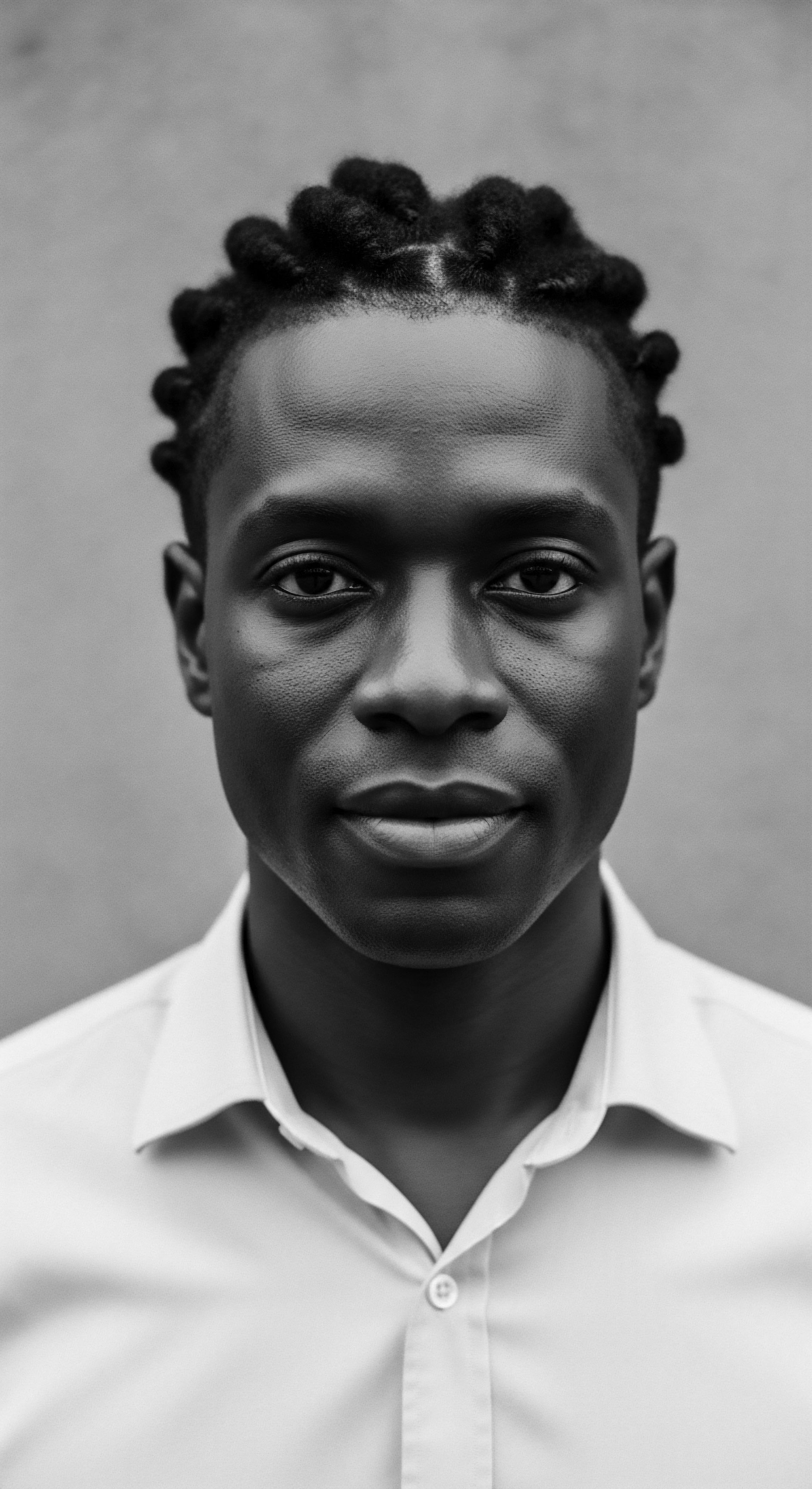
Roots
For generations, the very essence of textured hair, particularly within Black and mixed-race communities, has been inextricably linked to the wisdom of protection and preservation. This connection echoes from ancestral practices, where safeguarding the strands was not merely about aesthetics, but about health, identity, and cultural continuity. To truly grasp the lineage of modern bonnet materials, we must journey back to a time when ingenuity and necessity shaped the materials that shielded and honored textured hair.
These historical fabrics were not chosen by chance; they were selected for their inherent qualities, their ability to work in concert with the unique biology of coiled and kinky strands, and their availability within specific geographical and cultural contexts. The narrative of bonnets begins with a whisper from ancient times, a story of how our forebears understood hair’s vulnerability and its sacred place in their lives.

Ancient Textiles for Hair Preservation
Across various ancient civilizations, the understanding of hair’s delicate nature led to the use of specific materials for head coverings. While the modern bonnet, as we recognize it, gained prominence in later centuries, its foundational principles of protection and moisture retention were present in earlier forms of headwear. Consider the practices of ancient Egypt, where elaborate wigs were common, yet the natural hair beneath also received meticulous care. Egyptians utilized head coverings made of Linen to shield their hair from the desert’s harsh environment and maintain its moisture.
This demonstrates an early recognition of how certain fibers could interact with hair to prevent dryness and damage. Linen, derived from the flax plant, possesses a smooth surface that reduces friction, a quality that remains paramount in contemporary bonnet design.
Beyond Egypt, the vast continent of Africa holds a profound history of textile use for hair care and adornment. Before the transatlantic slave trade, various African cultures employed a diverse range of handcrafted textiles, each carrying deep cultural and practical significance. These materials were often selected for their breathability, softness, and ability to help retain moisture, a crucial aspect for textured hair which is naturally prone to dryness. The knowledge of these materials and their benefits was passed down through generations, a testament to ancestral wisdom.
The journey of bonnet materials for textured hair begins with ancestral knowledge of natural fibers and their protective qualities.

Hair Anatomy and Historical Care
The unique structure of textured hair, characterized by its helical shape and often porous cuticle, makes it particularly susceptible to moisture loss and mechanical damage. Historically, communities with textured hair understood this intrinsic vulnerability. They recognized that exposure to harsh elements—sun, dust, wind—could strip the hair of its natural oils, leading to breakage and dullness. This biological reality directly influenced the choice of materials for head coverings.
Fabrics that minimized friction and allowed the hair to retain its inherent moisture were favored. This ancestral understanding, though not articulated in modern scientific terms, aligned with what contemporary trichology confirms ❉ minimizing friction is key to preserving the integrity of the hair shaft.
The earliest forms of hair protection were likely simple coverings, perhaps made from readily available plant fibers or animal skins, adapted to provide a barrier against the elements. As textile technology advanced, so too did the sophistication of these coverings. The development of weaving techniques allowed for softer, more pliable materials that could be fashioned into forms that offered both protection and cultural expression.

Early Fiber Choices and Their Properties
- Flax ❉ Cultivated for millennia, flax yielded linen, a smooth, strong fiber. Its non-abrasive nature would have been beneficial for preventing tangles and breakage in textured hair, much like modern silk.
- Cotton ❉ While some cotton varieties can be absorbent, traditional, unprocessed cotton often possessed a softer hand than rougher fibers, and was readily available in many regions. Its use, particularly in later periods of the diaspora, adapted to its functional purpose.
- Animal Hair Fibers ❉ Though less common for direct head coverings in the same way as plant fibers, the knowledge of animal hair’s properties (like warmth and protection) influenced overall textile understanding. Wool, for instance, known for its resilience and protective qualities, has been used in various forms of clothing since Neolithic times.

Ritual
As we move from the foundational understanding of hair’s biological needs, we enter the realm of daily practice and cultural ritual. The materials chosen for head coverings, including the precursors to modern bonnets, were not simply functional; they became integral to the lived experiences of individuals and communities. This section explores how historical fabrics became intertwined with the routines of care, the expressions of identity, and the very spirit of resilience within textured hair heritage. The transition from raw fiber to cherished garment was a testament to human ingenuity and the deep connection to one’s hair.

Headwraps and Cultural Significance
The headwrap, in its myriad forms, stands as a powerful symbol across the African diaspora, deeply influencing the concept of protective headwear. Originating in Sub-Saharan Africa, these wraps conveyed age, marital status, wealth, and spiritual beliefs. The selection of fabric for these headwraps was deliberate, often reflecting regional traditions, social standing, and aesthetic preference.
For instance, the Yoruba and Igbo women of West Africa wore elaborate Gele headwraps, often made from vibrant, intricately patterned textiles, signifying status and celebration. These were not merely coverings; they were statements, crowns of cultural pride.
During the transatlantic slave trade, headwraps crossed oceans, carried by enslaved Africans as one of the few tangible links to their homelands. In the Americas, these head coverings took on layered meanings. While often enforced by slave owners as a mark of subservience, intended to strip Black women of their dignity and conceal their hair, enslaved women transformed them into symbols of resistance and identity. They used available materials, often simple Cotton Kerchiefs, to protect their hair from the harsh conditions of labor and to maintain a connection to their heritage.
The creative ways in which these wraps were tied and adorned became a silent language, a form of communication and defiance against oppression. (Kynard, 2013)
Headwraps, once symbols of status in Africa, were transformed into emblems of resilience and cultural continuity during enslavement.
A poignant historical example is the Tignon Laws of late 18th-century Louisiana. These laws mandated that free Black women wear headwraps (tignons) to distinguish them from white women and signify their social status. However, these women, with their indomitable spirit, subverted the intent of the law by using luxurious fabrics and elaborate tying styles, turning a tool of oppression into a fashion statement and a declaration of dignity. This historical act of reclamation underscores the profound connection between fabric, hair, and identity within textured hair heritage.

Material Evolution in Protective Headwear
The evolution of bonnet materials for textured hair is a narrative of adaptation and ingenuity. From the earliest protective coverings to the more refined sleep bonnets of later centuries, the core need remained ❉ to shield delicate strands from friction and moisture loss.
In the post-slavery era, as Black women continued to navigate societal pressures regarding their hair, headwraps and bonnets remained essential. While the stigma associated with head coverings persisted for a time, particularly when natural hair was deemed “unprofessional” (Banks, 2000), their practical benefits for hair health were undeniable. The advent of chemical relaxers in the early 20th century further cemented the need for protective headwear, as chemically treated hair required careful maintenance to prevent damage.

Transitioning Materials and Their Properties
The shift from utilitarian head coverings to specialized sleep bonnets saw a preference for smoother, less absorbent fabrics.
- Cotton ❉ While historically significant for its availability and use in everyday headwraps, raw cotton can be absorbent and create friction, potentially drawing moisture from hair. Its use in bonnets, however, has evolved with processing to be softer, or it is often used as an outer layer with a smoother lining.
- Silk ❉ Revered for centuries, silk stands as a superior natural fiber for hair protection. Known for over 5,600 years, with its origins in China, silk’s smooth protein structure minimizes friction, preventing breakage and preserving hair’s natural oils. Its use in modern bonnets is a direct echo of its ancient recognition as a luxurious and beneficial textile.
- Satin ❉ Often a synthetic weave designed to mimic silk’s smooth surface, satin became a popular and accessible alternative. Its slick surface helps hair glide, reducing tangles and frizz, much like silk. This material represents a contemporary adaptation of the protective qualities found in historical, finer textiles.
The choice of materials reflects a continuous dialogue between tradition, necessity, and scientific understanding. The ancestral knowledge of what keeps hair healthy, though perhaps not articulated in terms of protein structures or cuticle layers, led to practices that modern science now validates.
| Historical Material Linen |
| Traditional Use Context Ancient Egyptian head coverings for sun and moisture protection. |
| Hair Benefit (Modern Interpretation) Smooth surface reduces friction, aids moisture retention. |
| Historical Material Raw Cotton |
| Traditional Use Context Common in enslaved communities for practical protection and cultural expression. |
| Hair Benefit (Modern Interpretation) Provided a barrier against elements; cultural significance. (Modern cotton bonnets are often processed for softness or lined.) |
| Historical Material Silk |
| Traditional Use Context Luxurious headwraps in various African cultures; valued for softness. |
| Hair Benefit (Modern Interpretation) Minimizes friction, prevents breakage, preserves natural oils and moisture. |
| Historical Material These materials, chosen through generations of experience, laid the groundwork for modern bonnet design, underscoring a continuous lineage of hair care wisdom. |

Relay
How does the enduring legacy of historical fabrics continue to shape our contemporary understanding of hair care and identity, particularly for textured hair? This question beckons us to consider the profound, interwoven tapestry of science, culture, and ancestral wisdom that defines the modern bonnet. We are not merely talking about a piece of cloth; we are exploring a continuum of care, a symbol of heritage that has adapted through time, carrying the echoes of resilience and self-preservation into the present day.

From Ancestral Protection to Modern Innovation
The modern bonnet, particularly those crafted from silk or satin, represents a direct continuation of ancestral practices focused on hair preservation. The scientific understanding of textured hair reveals its susceptibility to moisture loss due to its unique coil patterns and raised cuticle layers. When hair rubs against abrasive surfaces like cotton pillowcases, it creates friction, leading to breakage, frizz, and dryness. This scientific reality validates the ancient wisdom that favored smoother materials for head coverings.
The shift towards silk and satin in modern bonnets is not a new invention but a rediscovery and re-application of principles long understood by our forebears. Silk, a protein fiber known for its smooth surface, allows hair to glide freely, significantly reducing friction and preventing tangles. This characteristic directly addresses the mechanical damage that textured hair can experience during sleep. Satin, often a synthetic alternative, mimics these beneficial properties, offering a more accessible option that still provides a low-friction surface.

Why Silk and Satin Prevail
The preference for silk and satin in modern bonnet materials is rooted in their unique properties that align with the specific needs of textured hair:
- Reduced Friction ❉ Both silk and satin possess a smooth, slick surface. This minimizes the rubbing and snagging that can occur between hair strands and coarser fabrics, thereby preventing mechanical damage like split ends and breakage.
- Moisture Retention ❉ Unlike absorbent materials like cotton, silk and satin do not draw moisture away from the hair. This allows textured hair, which naturally tends to be drier, to retain its essential hydration, keeping it supple and less prone to brittleness.
- Preservation of Style ❉ By reducing friction and maintaining moisture, these fabrics help to preserve hairstyles, whether natural curls, braids, or straightened looks, for longer periods, reducing the need for frequent re-styling and manipulation.

The Bonnet as a Cultural Beacon
Beyond their scientific benefits, modern bonnets carry a profound cultural weight, serving as a contemporary emblem of textured hair heritage. The act of wearing a bonnet, particularly within Black communities, is a quiet ritual of self-care and a nod to a long lineage of protective practices. It is a daily affirmation of valuing one’s natural hair, a counter-narrative to historical pressures that often devalued textured hair in its authentic state.
Ingrid Banks, in her work, discusses how hair serves as a site where ideas about race, gender, sexuality, beauty, and power are articulated within Black women’s consciousness (Banks, 2000). The bonnet, then, becomes a tangible manifestation of this consciousness, a personal and collective act of reclaiming and celebrating Black beauty standards. The widespread adoption of bonnets and similar head coverings, like durags for men, reflects a continued commitment to hair health and a vibrant expression of cultural identity.
A notable statistic that powerfully illuminates this connection to textured hair heritage and Black experiences is the enduring use of protective head coverings. Even after the abolition of slavery, when headwraps were still associated with servitude, Black women continued to use them for hair preservation. This historical continuity, spanning centuries, speaks to the inherent understanding of hair’s needs and the resilience of cultural practices. In the early 2000s, as the natural hair movement gained momentum, the bonnet saw a resurgence, becoming not just a functional item but a visible symbol of self-acceptance and pride in one’s textured hair.
| Historical Purpose Protection from elements and labor (e.g. sun, dust, sweat on plantations). |
| Modern Heritage Connection Shielding hair from environmental damage and preserving styles during sleep or daily activities. |
| Historical Purpose Symbol of status or tribal affiliation in pre-colonial Africa. |
| Modern Heritage Connection Expression of cultural pride, identity, and a conscious choice to care for textured hair. |
| Historical Purpose Resistance against oppressive laws (e.g. Tignon Laws). |
| Modern Heritage Connection A quiet act of self-love and defiance against Eurocentric beauty standards. |
| Historical Purpose Practicality for chemically treated hair (early 20th century). |
| Modern Heritage Connection Essential for maintaining hair health across all textured hair types, whether natural or chemically altered. |
| Historical Purpose The bonnet's journey from historical necessity to modern staple highlights its enduring role in supporting textured hair health and affirming cultural identity. |

Interplay of Science and Heritage in Hair Care
The continuous dialogue between traditional knowledge and modern scientific understanding is at the core of textured hair care. What our ancestors intuitively knew about the protective qualities of certain fabrics, modern science can now explain at a molecular level. The protein structure of silk, for example, is remarkably similar to that of human hair, leading to less friction and static electricity when they interact. This scientific insight provides a deeper rationale for the centuries-old preference for smooth materials.
The current landscape of bonnet materials reflects this ongoing exchange. While natural fibers like silk remain highly valued for their inherent benefits, synthetic innovations have broadened accessibility. The development of specialized weaves and blends ensures that the protective qualities once found only in rare or costly materials are now available to a wider audience, democratizing a heritage practice. This evolution speaks to the dynamic nature of tradition, where core principles adapt to new knowledge and technologies, always with the ultimate goal of preserving and celebrating textured hair.

Reflection
The journey of historical fabrics influencing modern bonnet materials for textured hair is more than a mere chronology of textiles; it is a profound meditation on heritage, resilience, and the enduring wisdom of our ancestors. From the practical coverings of ancient civilizations to the symbolic headwraps of the diaspora, and now to the ubiquitous silk and satin bonnets of today, each stitch carries a story. This story speaks to the deep connection between hair and identity, a connection that has been nurtured, protected, and celebrated across generations, reminding us that true care is always rooted in respect for what has come before.

References
- Banks, I. (2000). Hair Matters ❉ Beauty, Power, and Black Women’s Consciousness. New York University Press.
- Byrd, A. D. & Tharps, L. L. (2001). Hair Story ❉ Untangling the Roots of Black Hair in America. St. Martin’s Press.
- Gillow, J. (2009). African Textiles ❉ Color and Creativity Across a Continent. Thames & Hudson.
- Kynard, C. (2013). Wrapping Our Heads ❉ Archiving Black Women’s Style Politics. Education, Liberation & Black Radical Traditions for the 21st Century .
